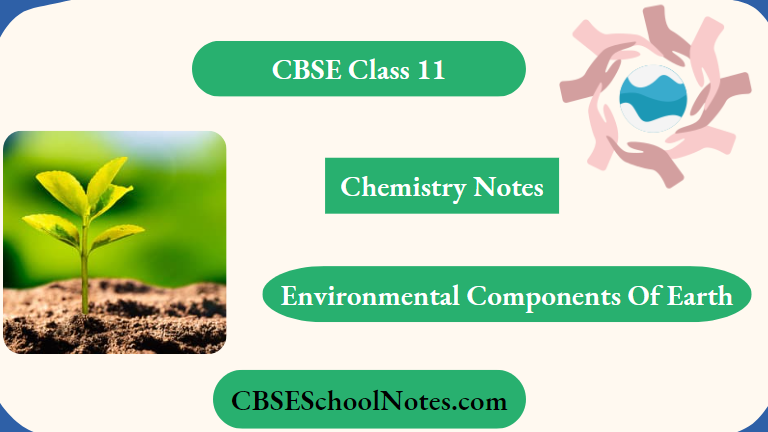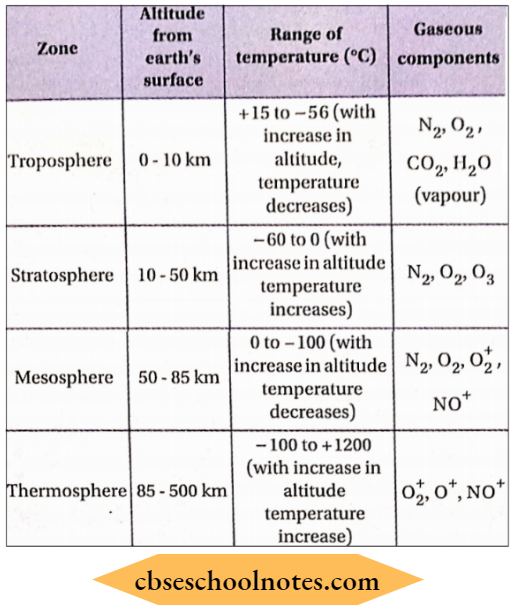Environmental Components Of Earth

Earth’s environment is composed of the following four components—
- Atmosphere,
- Hydrosphere
- Lithosphere and
- Biosphere.
Among these, the first three components are abiotic while the fourth one is biotic.
- Atmosphere: The invisible gaseous layer that surrounds and protects the Earth is called the atmosphere.
- Hydrosphere: It includes all sources of water such as seas, oceans, rivers, fountains, lakes, polar regions, glaciers, groundwater etc.
- Lithosphere: It comprises of the solid crust of the earth, made of rocks, forming the outer mineral cover.It includes soil, minerals, organic matter etc., and extends up to a depth of about 30 km from the earth’s surface.
- Biosphere: It is that part of the earth where living organisms exist and interact with each other and also with the non-living components. Biosphere consists of all three zones.
- For example: Soil, water, air etc., where living beings exist
Read and Learn More CBSE Class 11 Chemistry Notes
Atmosphere
The invisible blanket of the gaseous layer that surrounds the earth is called the atmosphere. It extends upwards to about 1600km. It is the gravitational attraction of the earth that holds this gaseous layer closely in space around the earth’s surface. The total mass of gaseous substances in the atmosphere is nearly 5.5×1015 tons.
Based on temperature gradients and altitude, the atmosphere has been divided into four distinct zones.
These are:
- Troposphere
- Stratosphere
- Mesosphere and
- Thermosphere
Different zones of atmosphere:

Again according to the proportion of different gases from the surface of the earth towards
The vacuum of interstellar space and atmosphere can be divided into two categories:
- Homosphere and
- Heterosphere.
Homosphere extends from the surface of the earth upto about 100 km height. In this layer, the proportions of different gases are more or less identical. Thus, this layer is called the homosphere. The layer next to it is known as the heterosphere because the proportion of the gases in the different parts of this layer are found to be dissimilar.
Gravity holds most of the air molecules close to the earth’s surface and hence the troposphere is much more denser than the other layers. 50% of the total mass of the atmosphere exists within a height of5.5 km from the earth’s surface and 99% exists within a height of 30 km from the earth’s surface
Average gaseous composition in homosphere

Functions of gases present in the atmosphere
1. Oxygen:
- The most significant gaseous constituent of the atmosphere is oxygen. Oxygen is indispensable for any kind ofcombustion.
- Oxygen is also used for the oxidation of food taken by plants and animals to produce heat and energy.
- Oxygen is a necessary component of life as all living beings (except some microorganisms) and plants take oxygen from the atmosphere for respiration. Plants give up oxygen to the atmosphere during the process of photosynthesis.
- As a result, the balance of oxygen is maintained in the atmosphere.
2. Nitrogen:
- The major constituent of the atmosphere is nitrogen. Proteins and nucleic acids present in living bodies are nitrogenous compounds.
- But most of animals including human beings and even plants cannot utilise atmospheric nitrogen directly for the production of proteins and amino acids.
- However, some nitrogen-fixing bacteria can take nitrogen directly from the air and produce nitrate salts in the soil.
- These are used by plants in the synthesis of amino acids and nucleic acids. Herbivorous animals meet their protein demand by eating those plants. Similarly, carnivorous animals get proteins from herbivorous animals.
- After the death of plants and animals, nitrogenous compounds present in their bodies are decomposed by some bacteria releasing nitrogen gas that returns to the atmosphere.
3. Carbon dioxide (CO2):
- Combustion of fossil fuels and carbonaceous compounds, and respiration of plants and animals increase carbon dioxide content in the atmosphere.
- Again plants, during photosynthesis, absorb carbon dioxide from the atmosphere for the preparation of food.
- As a result, the balance of carbon dioxide is maintained in the atmosphere.
- But due to excessive … combustion of carbonaceous fuels and indiscriminate deforestation, the quantity of carbon dioxide in the atmosphere is increasing constantly leading to a constant increase in the average temperature of the earth (See Greenhouse effect).
4. Ozone:
- The quantity of ozone gas present in the atmosphere is negligible.
- Almost the entire amount of ozone (=90%) is present in the stratosphere whichis about 15-35 km above the earth’s surface.
- Presence of ozone gas close to the earth’s surface hurts mankind and other animals.
- But the presence of ozone in the upper layer of tyre atmosphere is beneficial since it absorbs the harmful ultraviolet rays of the sun
